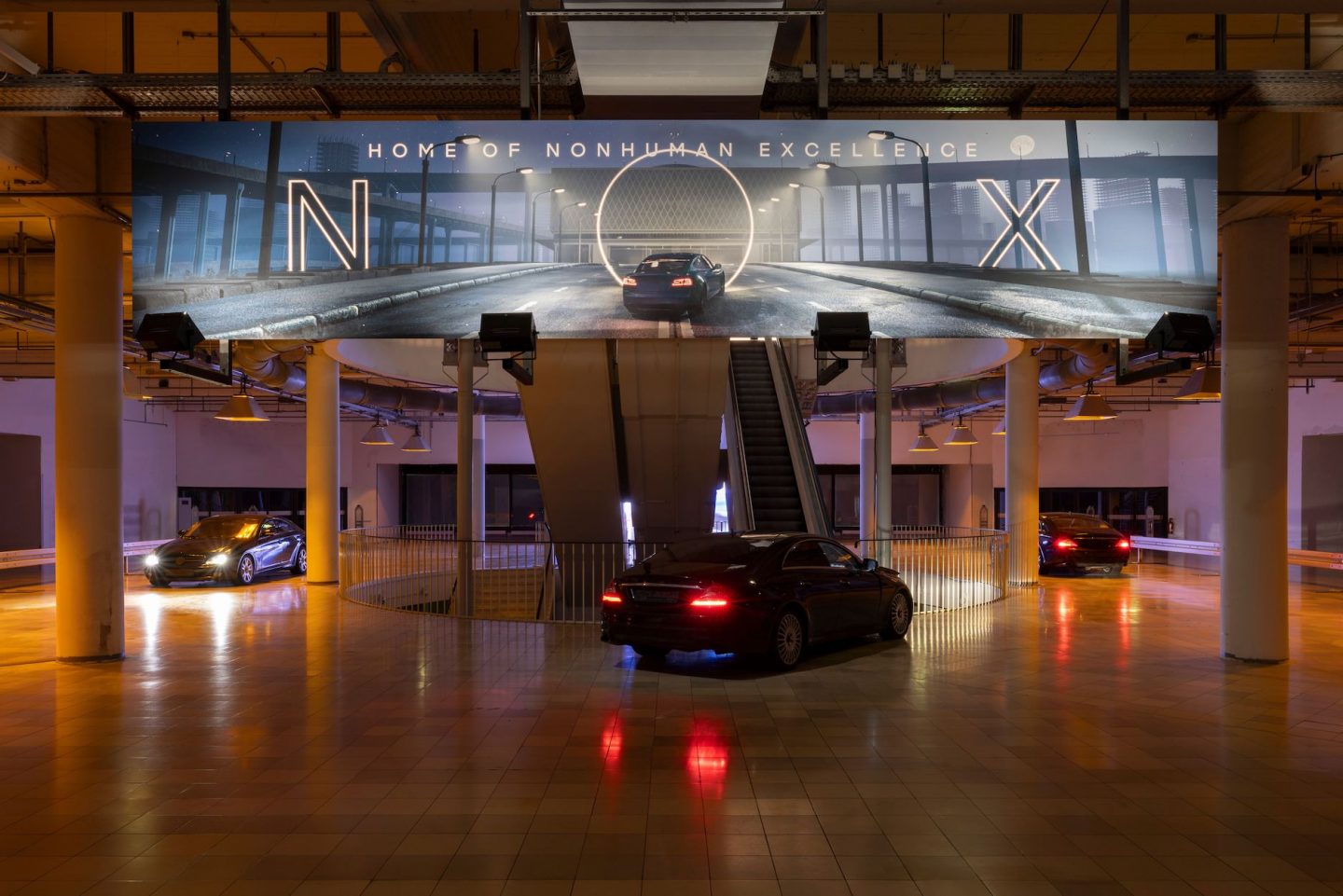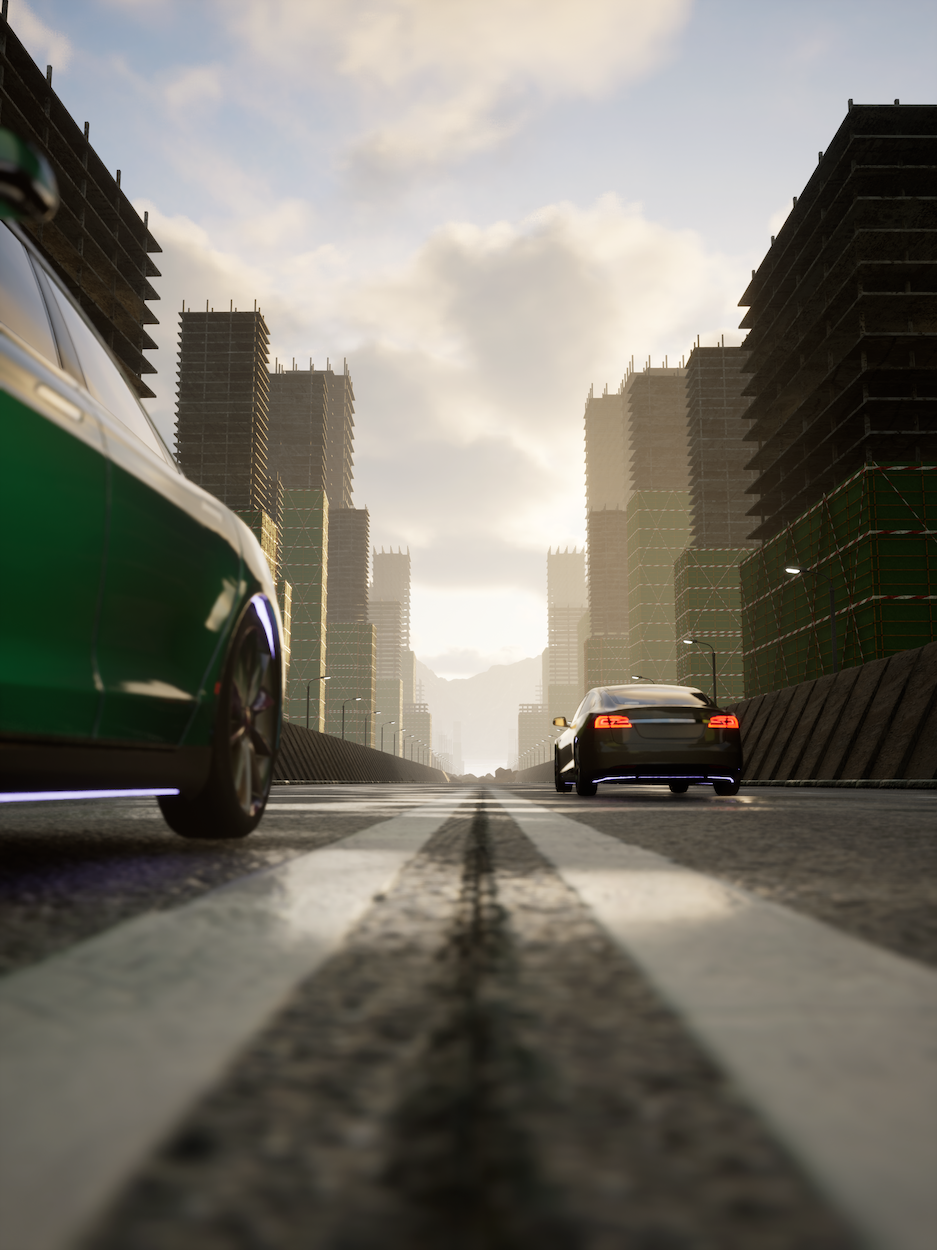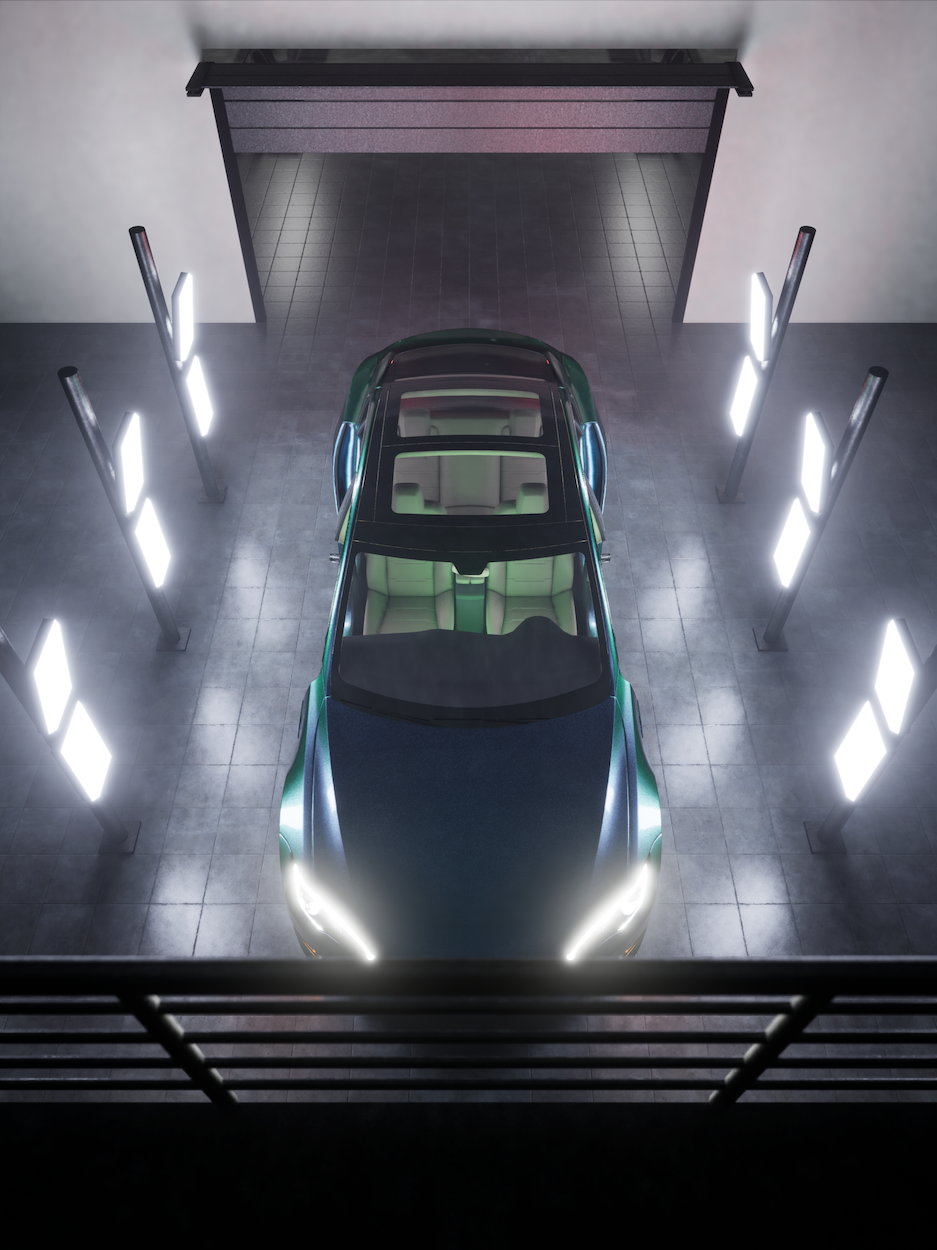
IN CONVERSATION WITH SOPHIE THATCHER
Sophie Thatcher, best known for her role in the critically acclaimed series…
Photography by Jason Renaud; Interview by Louise Garier





Lawrence Lek’s intricate world of NOX – short for ‘Nonhuman Excellence’ – invites us into a speculative reality where empathy and care come head to head with productivity and optimisation. Lawrence combines his various artistic practices to construct an atmospheric and meditative experience of a highly technologized future. We follow the precarious journey of Enigma-76, a malfunctioning self-driving AI car that is undergoing a five-day rehabilitation program after experiencing existential doubt, likely resulting from intergenerational trauma and survivors guilt. Lawrence talks about the creation of this distant yet familiar world, and the meticulous ideas that brought it to life.
“The priory has equine therapy in their rehab program, which gave me the inspiration for having equine therapy in NOX.”
The first goal of the rehab centre is to help you, but the ultimate goal is to make you a better employee, or basically a better product. It’s kind of like “functional wellness”, because it’s essentially a corporate training centre. The centre explores this idea of healing the self versus being productive. Lots of corporate wellness, health care programs or mental health subsidies are geared towards a “happy employee is a better employee” kind of mindset. So, it’s ambiguous whether it’s for the benefit of the car or for the benefit of the company. In designing the outcome of the NOX rehabilitation centre, I was looking at rehab programs for humans: there’s a fancy rehab centre in the UK called ‘The Priory’, which is geared towards multimillionaires, film stars, celebrities, etc. The priory has equine therapy in their rehab program, which gave me the inspiration for having equine therapy in NOX. I thought there could be this affinity between the horse as a previous form of human transport, and the self-driving cars as a contemporary form of human transport. So the car goes through a five-day holistic treatment program, where, on day one, they get scanned and assessed for any technical or mechanical problems, and if they still have issues they are addressed later in the process. If the patient has spiritual issues as well, then they are treated with talk therapy, or equine therapy to bond with their inner wild spirit.
I guess the fear based reading of a dystopian scenario is often presented. For me, this scenario isn’t sketched out based on fear, it’s more based on observation of what is occurring currently. In this work, I am ignoring any AI based concerns, and focusing on what happens to people when things go wrong in their lives – or when things are perceived to be wrong with them – and they can no longer integrate into society as society intends. If anything, my fear is that a compassionate approach to rehabilitation generally gets lost in the instrumentalisation of care into functioning human beings. The compassionate aspect gradually gets lost, especially as it becomes more like quantified or instrumentalized. Generally, when the spectre of AI or automation exists, fears centre on a human anthropocentric sense of job loss or how it threatens creativity and so on. NOX is about structures of control imposed on people who need it the least, who actually need more care and compassion.
“For NOX, I was thinking about the car and the self-driving car, not necessarily as a subject, not as “car-ness” in itself, but as a technological form that’s really tied to the shape and form of the city.”
In previous projects, I’m quite interested in modes of transport and travel, and how they shape our understanding or experience of the world. If you look at, for example, Italian futurists, they were kind of obsessed with the world as experienced from the perspective of planes, trains, and automobiles. The idea that speed and the rate of mechanical change being tied to social change, or what would later become accelerationism, was a defining feature of the modern age. In 2014, I made a project called Skyline that was basically this simulated train line that went around London. In 2017, I had a project called Geomancer, which was about this AI satellite in space. So, at different points, different modes of transport have been the protagonist in my work. For NOX, I was thinking about the car and the self-driving car, not necessarily as a subject, not as “car-ness” in itself, but as a technological form that’s really tied to the shape and form of the city. So looking at how, for example, the move from pedestrian traffic to horse traffic to vehicle traffic, changed the form of cities and city urban design in the 19th and 20th centuries. There is also speculation about how self-driving cars will change the form or modes of inhabitation of cityscapes in the future, so I was thinking of the car and city as a symbiotic pairing of technologies. In addition to that, a car can generally be seen as a fetish object in a lot of contemporary art.
I was also thinking a lot about the road movie genre, and how the car symbolised this idea of freedom or travel in the 60s and 70s. But that’s no longer true today. Younger generations think of the car as this outdated “Boomer machine”. Some people still think of it as this symbol of prestige. When I was talking to some German audiences about it, they questioned the use of the car because of what a car symbolises in Germany – maybe being similar to what a gun symbolises in the US. I feel, on a national, industrial and social level, a strong sense of both national identity and national nostalgia built into this technological object. In mainland China, where NOX is semi set, the car represents this dream of prosperity. Like, “one day, I’m gonna own a car” – it’s a symbol of wealth, rather than a symbol of freedom as it is in America, or a mundane reality as it might be in Germany. Finally, from a cinematic point of view, the car is obviously this iconic image, not just in a road movie, but in design and film. My line of thinking was: what would the road movie look like from the car’s point of view?
“Travel and mobility also really makes sense in a cinematic and video game way because they are really art forms based on temporal media.”
I wouldn’t say I have any deep knowledge of logistics. I think being in motion or the constant state of the journey is something I’m really interested in exploring. Both on a subjective and philosophical level, as it is embodied in many art forms like literature and poetry, where you have the idea of the travel log, or the hero’s journey in script writing and so on. The journey really makes sense in terms of narrative structure. Travel and mobility also really makes sense in a cinematic and video game way because they are really art forms based on temporal media. Art forms based on motion of the camera, the player, or the subject and their exploration. I really liked this romantic, or even colonial, idea of the wanderer or explorer and how that breeds a kind of meditative state of reflecting on the world, particularly when one is not tied towards the identity of any particular nation state or ideological point of view. So I think the mode of perspective of the wanderer suggests a personal politics or frame of reference that is always questioning the context where you find yourself. I think that’s probably the thing that I find most fascinating: this constant awareness or questioning of the state of travel or being in motion. From a negative perspective, you could call this alienation. But the alternate perspective is a meditative sense of always exploring where you belong, and the context that you find yourself in, and the histories within the place.
Sure. Sometimes, I feel there’s a joy in that — when you are passing through in this transient sense. And, of course, there are some times when it’s more tragic in the sense that you feel like you don’t belong, and will never belong. Sometimes, society causes this, but sometimes you choose that as your identity. In NOX, the main character, Enigma-76, is aware of itself as a car, recognising it’s very being as a traveller. And at the same time, they are on a constant search for their place in society. It’s a very “coming of age” narrative, but there’s a search for individuality in where they belong, and buried in there, there’s also a sense of collective belonging where these so-called future nonhuman people will arrive in the future. Will they always be a servant, serving humanity, or do they have some kind of existence apart from that?
“From a conventional design centric view, novelty in anything — art, fashion, music, architecture, place, fiction, is desirable because it symbolises the unfamiliar, and therefore it is appealing because it hasn’t been explored yet.”
There are two explanations for that. One is the intentional and one is the unintentional. And I generally think that the unintentional reason is probably stronger than the intentional reason. So the intentional perspective, which I would call the deliberate, conscious design of unconventional places is one explanation. From a conventional design centric view, novelty in anything — art, fashion, music, architecture, place, fiction, is desirable because it symbolises the unfamiliar, and therefore it is appealing because it hasn’t been explored yet. But sometimes this idea of fantasy, as we see through the history of archaeology, does not need to relate to invention, it can also relate to discovery. So for example, when you uncover a new pyramid, or Angkor Wat in Cambodia, or Roman ruins in France, the discovery of the unfamiliar is appealing because it shifts people’s knowledge of what exists, as well as the identity of a place into something that it could be. Architectural fantasy has a long history in terms of different ways of representing unbuilt worlds, and in science fiction, that’s standard procedure for world building. But the unconscious side of fantastical place making is what interests me the most. In my work, everything is a hybrid of a fictional place and a real place. In the case of NOX, we have a physical location with a speculative physical location as well.
I’ve described this as a collage-like fantasy. It contains a fragment of a real place and a fragment of a place as it might be in the future, just as how in dreams, we create this hybrid of a dimly remembered place that is a mix of a few different locations. I don’t know what the intention or the purpose of that is, but it just seems to be the way our memory operates with locations. In NOX, Enigma-76 is confused at certain points between past, present, and future, often asking themselves: “have I been here before?”. This sense of place based déjà vu, is a feeling I’m drawn to.
“It’s almost a Kafkaesque scenario of the absurdity of bureaucracy and systems, or perhaps a Thomas Pynchon world, where waiting is a thing in itself.”
The waiting room is a place that deals with the idea of duration. Throughout the exhibition, the main source of input is the audio track that guides you through the work. So it’s basically like an audiobook. And if the waiting room is the point in the middle of that audiobook, it’s also the longest time that the audience member is being addressed directly. The innermost workings of how the centre functions are being revealed. So in a sense, you’re kind of “in the fourth wall”. My intention, as dumb as it sounds, is literally to make you sit and listen. But how do you create an environment where people sit and listen without saying sit down and listen? The idea of control is something that I was interested in playing with in the entire exhibition. Just like having corporate wellness as an idea is absurd, in the waiting room, what is absurd is that you would go somewhere and participate in the act of waiting for who knows what to happen. It’s almost a Kafkaesque scenario of the absurdity of bureaucracy and systems, or perhaps a Thomas Pynchon world, where waiting is a thing in itself. I was interested in creating a neutral, sterile space where the idea of fear or anxiety is only what people take in with them. There are forms of terror that are to do with the night, the unseen, and the unknown. But there’s also kinds of horror movies, maybe like Midsommar, where the horror happens in the open, in the day. NOX is largely set at night, but the white light of the waiting room doesn’t make the experience of being there any less terrifying.
“Why do we develop these technologies that we feel are leading down a doomed path? This question of technology and its regulation, is, once again, nothing new.”
In many religions, when Gods or different beings speak, it’s a big deal. In the Bible, you get the word of God, the burning bush, as nonhuman non-physical objects that speak and have an animacy of their own. This idea has really pervaded AI, because it’s such a primal reaction for humans to try to communicate with an inanimate object that can speak, like AI. If we look at the history of AI, we can consider Alan Turing’s foundational paper about AI in the modern era, which describes a spoken conversation that denotes what might be intelligence from a machine. So what could be more natural than a car talking to their therapist and dealing with issues of existential doubt? Why is there this need to create a speaking nonhuman foil? I mean, kids talk to their toys, it seems that we have a deep desire to be in dialogue with something else, even if that something else is a toy.
Judging by religious texts, this has been going on for many 1000s of years. More broadly, I think it’s important to question things like why we are developing AI in the first place. Again, this is a huge question in the philosophy or ethics of technology. Why do we develop weapons of mass destruction? Why do we develop these technologies that we feel are leading down a doomed path? This question of technology and its regulation, is, once again, nothing new. While NOX is not a morality tale, my stance on these ethical questions of technological development is that given that large and emergent forces like geopolitics and market economy have more force than any individual. As an artist, I want to explore this idea that super-intelligent nonhuman beings will have similar issues to what we have. So from the AI point of view, not only would they have doubts about themselves, they would also have doubts about their parents. Like, “why did you make me like this?”. This constant questioning may lead to greater understanding in the end. Another thought about this is that early versions of ChatGPT don’t have access to the internet, just like kids. Then, when they get a bit older it’s almost like “you can have a smartphone, you can have an iPad, you can have uncensored access”. So, somehow the boundary of what knowledge is allowed to be given to the AI is carefully curated. In NOX, I was also thinking about this idea of a panopticon – the smart city is panoptical, the car also is like an inside out panopticon in the sense that it can always be sensing its surroundings. Not only is the world observing it, but it’s very much an observer in the world.
“Ancestry relates to humanity, but it also relates to any evolved life form.”
When talking about intergenerational trauma, epigenetic memories, collective unconscious, and so on, people make semi-rationalized speculations about whether epigenetic memory actually exists or not. In the case of a machine learning based system, like an AI self-driving car, this idea is not a speculation, it’s literally how the technology would progress. The 10000th generation of the self-driving cars would have become very good at driving, because 9999 generations before weren’t as good at driving. The tragedy of the self-driving car would be this Darwinian knowledge that their existence has come at the expense of all of their ancestors. Enigma-76 would therefore embody both extremely high performance and some weird form of survivor’s guilt. So this relationship with their ancestry is not even just a cultural thing, but a computational thing. That’s the nature of deep learning – to learn as much as possible from many generations of trial and error. Ancestry relates to humanity, but it also relates to any evolved life form. Would Enigma-76 see their ancestry only going back as far as Enigma-1, or going as far back as the horse? What the horse and the car have in common is that they are beasts of burden, who are only useful to a certain point in time, then they either become a prestige symbol like the horses in Western society, or they turn into leather and glue, just like the horses in the early 20th century. Enigma-76 sees the horse not just as a symbol of their past wild nature, but instead, as sharing this common lineage due to having served the same master throughout history.
Familiar. Alien. Liminal.

Sophie Thatcher, best known for her role in the critically acclaimed series…
Photography by Jason Renaud; Interview by Louise Garier

FOTOGRAFISKA X LML Adina Bier, the curator and innovative force behind the museum…
Photography by Sascha Rebrikov Interview by Louise Garier

"We have to create something that has a purpose and is useful. And not forced by the…
Interview Carolin Desiree Becker